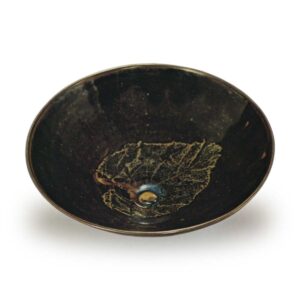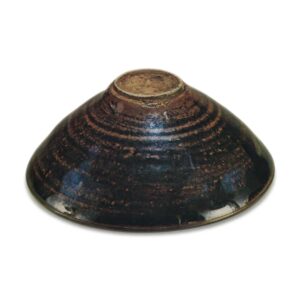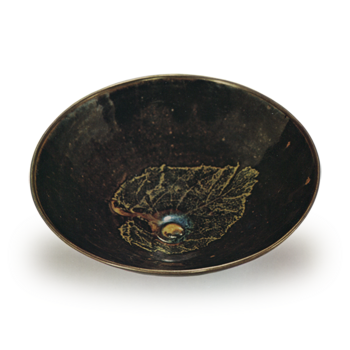

Goto Museum of Art
Height: 5.5 – 5.8 cm
Diameter: 15.0 cm
Foot diameter: 3.9 – 4.0 cm
Height of rim: 0.3 cm
There are quite a few examples of mokuho tenmoku, but most of them are excavated items that have been brought to Japan from China in recent years, and examples that have been handed down in Japan are extremely rare. Although the details of the history of this tea bowl are not clear, it is an excellent Mokuho Tenmoku with a unique charm that only the Tenmoku tea bowls that have been handed down in Japan possess.
The shape is a thin, flat tea bowl with an open mouth, similar to the shape of a teapot lid, and it has a low, small foot ring.
The clay is a yellowish grayish-white, and the glaze is a dark purple-brown that is applied both inside and out, with a yellowish-amber leaf pattern appearing in the center of the bowl. The leaf pattern not only clearly shows the veins and leaf stems, but also spreads out freely almost to the center of the bowl. This is a technically successful example, compared to many other Mokuhyo Tenmoku where the leaf edges are bent or rolled inwards to create an abstract shape. As is generally thought, the leaves are attached to the black glaze and fired, so it is inevitable that the leaves will deform as the heat is applied, but in this case, this was not the case. The yellowish-amber color of the leaf pattern is quite a bright tone, and it is also interesting that the area around the central knot-like protrusion is tinged with blue, like sea cucumber. The purple-brown glaze that covers the entire surface has turned a persimmon color in places on the outside, and this is particularly noticeable around the foot ring. The inside is uneven, with purple and brown areas intermingled, and there are many small yellow-amber flecks scattered here and there. A metallic luster appears on the entire surface, giving it a unique charm. In the case of the taiha-gai, there are sometimes examples where a metallic luster appears on part of the surface, but it is rare for the entire surface to sparkle like a rainbow. It is probably the case that, over the course of many years, certain metals in the glaze have risen to the surface of the glaze and formed a thin film, creating the so-called luster phenomenon.
The rim of the bowl is decorated with a true-luster border.
The kiln site was investigated by Jiang Xianbo, who reported that the kiln site produced a type of Tenmoku called Mokuhyo Tenmoku.
There is no accurate data on the date of production, but looking at the shape and style of the tea bowl, it is thought to have been produced in the Southern Song dynasty, around the 13th century.
This is one of the most outstanding examples of mokuha tenmoku in Japan, and it is thought that it was brought to Japan early on and treasured.
After the war, it was passed from one family in Tokyo to Keita Goto, and is now in the collection of the Goto Museum of Art.
(Rakuji Hasebe)



